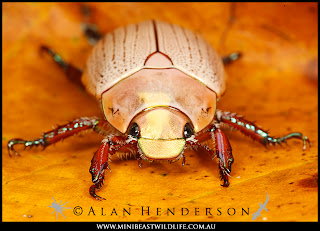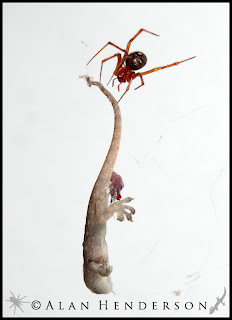Christmas beetles have made a welcome appearance to our lights over recent nights, the photos below are beetles that appeared tonight.
This attractive beetles belong to the Scarabaeidae family and are in the genus
Anoplognathus. We
have over thirty species of Christmas beetles in
Australia, many are found along the east coast. In some regions they have become more
abundant where land clearing has provided additional grasslands which host the beetles' larvae.
The life cycle of these beetles is the same basic cycle as
most beetles. In this case, eggs are laid underground in grasslands adjacent to
eucalypt trees or forests. The larvae feed upon grass roots and their
growth is dependant on soil temperature. Those in warmer climates may emerge a
year later, whilst those in cooler regions may spend two years underground. The
larvae are crescent-shaped with a pale, reddish-brown head and three pairs of
legs, but can be quite difficult to distinguish from other beetle larvae.
 |
| A green Christmas beetle, Anoplognathus smaragdinus |
 |
| The face of Anoplognathus smaragdinus |
After pupating, the adults time their emergence with warmer
conditions and are also stimulated by rainfall. Different species will emerge
at different times throughout the summer; perhaps to avoid direct competition.
Other factors can influence the exact timing of their emergence, such as
seasonal variations in weather patterns. Most Christmas beetles emerge from
November to February, but as we know, many appear in late December.
 |
| Anoplognathus porosus |
Christmas beetles are good flyers and can cover distances of
several kilometres. Many fly at dusk, but they are often attracted to lights
after dark and can end up buzzing around the front porch.
 |
| Anoplognathus porosus about to take off |
 |
| Anoplognathus porosus in flight |








